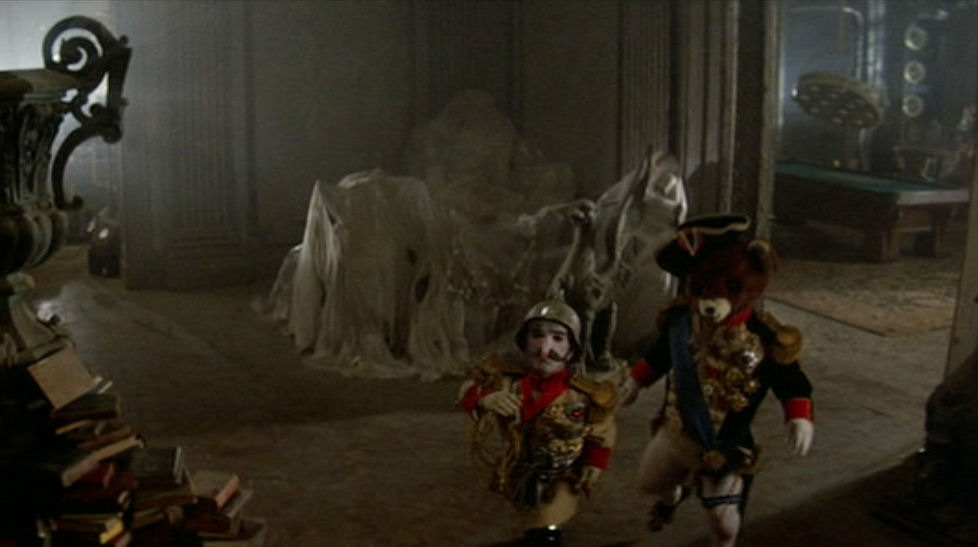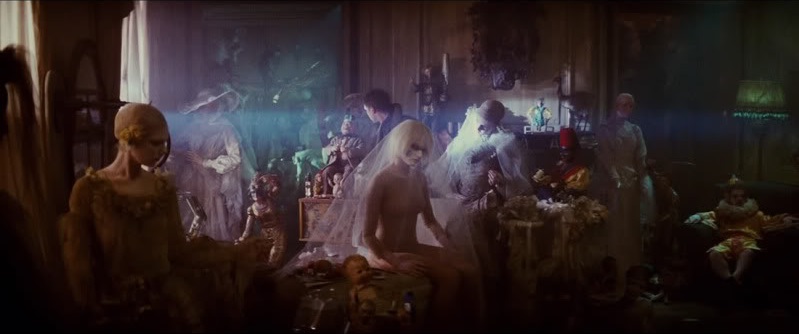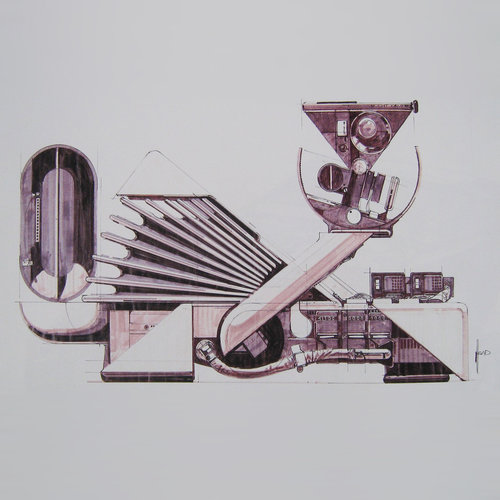Blade Runner Blues - Vangelis
composed by Greek electronic music composer Vangelis(Evángelos Odysséas Papathanassíou) . Everything came purely from the film itself -- the characters, the settings, the atmosphere, the story, the whole thing. . . Most of the music contained in this album originates from recordings I made in London in 1982, whilst working on the score for the film Blade Runner. Finding myself unable to release these recordings at the time; it is with great pleasure that I am able to do so now. Some of the pieces contained will be known to you from the Original Soundtrack of the film, whilst others are appearing here for the first time. Looking back at Ridley Scott's powerful and evocative pictures left me as stimulated as before, and made the recompiling of this music, today, an enjoyable experience. (Vangelis, Athens, April 1994) . Vangelis recorded, mixed and produced the score for "Blade Runner" in his own recording space, Nemo Studios, in 1982. He utilised many contemporary electronic instruments in order to create the atmospheric soundscapes, which he crafted on an ad-hoc basis. This was done by viewing videotapes of scenes from the film in the studio, and then improvising pieces in synchronisation with the images on the screen. He also applied the use of some foley techniques, using the synthesisers to produce diegetic and non-diegetic sounds. The most prominent synthesiser used in the score was the Yamaha CS-80, which can be heard in the opening scenes, and subsequently throughout the rest of the film. Other synthesisers employed by Vangelis included four Roland instruments: the ProMars, the Jupiter-4, the CR-5000 drum machine, and the VP-330 Vocoder Plus; a Sequential Circuits Prophet-10; a Yamaha GS1 FM synthesizer; and an E-mu Emulator sampler. A Steinway grand piano, a Yamaha CP-80 electric grand and a modified Fender Rhodes were also used. He also utilised a variety of traditional instruments, including, gamelan, glockenspiel, gong, snare drum, timpani and tubular bells.
[Edited 9/5/19 9:51am] | |
- E-mail - orgNote -  Report post to moderator Report post to moderator |
"Nothing is worse than an itch you can never scratch!"
Analysis of an Itch By Justin Case Blade Runner, directed by Ridley Scott, is brimming with symbolism. Each symbol can be correlated with the many different themes throughout the movie. Death plays a role in all of larger messages, and not surprisingly this film style is film noire. Almost every line of the movie can be expanded from it's literal meaning into a broader theme. The line with the most interesting double meaning is Leon's "Nothing is worse than an itch you can never scratch". Even with his class C intelligence rating, he has summed up Rachael's, Deckard's, and his own situation. Which is a terrible dilemma without an easy solution. . Leon knows he is facing death, but was not given the intelligence needed to fight it at the source like Roy Batty. His intelligence rating is only "C" but his strength is "A". So his solution is violence, when he was clearly failing Holden's Voight-Kampff test, he shoots Holden. There is anger in his voice "I'll tell you about my mother!" Like a three year old throwing a temper-tantrum he beats Deckard senseless. Once he knows his "expiration date" he wants to show Deckard the fear he holds. While choking Deckard, Leon states: "painful to live in fear, isn't it?" Literally death is the itch you can never scratch. His pictures are his security blanket. Roy asks him if he got his precious pictures. His design was flawed, he doesn't have the mental capacity to control his strength. It is this weakness that leads to his death. . Deckard especially is in a precarious situation. His job was to kill, upon detection, replicants. He is pressed back into service to retire Roy, Zhora, pris, and Leon. These replicants are not machines with plastic bodies, they are genetically engineered humans. Within a few short years they could develop their own memories and with memories come emotions. After the first few years there would be no detectable differences between them and humans. Bryant told Deckard: "They were designed to copy human beings in every way except their emotions. The designers reckoned that after a few years they might develop their own emotional responses. You know, hate, love, fear, envy." From the beginning the differences are so subtle that without the lengthy Voight-Kampff test, replicants could probably live their whole lives as normal humans. . Unfortunately, Deckard is the best at this unsavory job. His occupation leads him into the worst dilemma; after shooting the first replicant Zhora, Bryant adds another burden, Deckard is to execute Rachael. The complications are soon to arise, in the next scene Leon seeks revenge on Deckard. Using his superior replicant strength, Leon is about to teach Deckard about death. "Nothing is worse than an itch you can never scratch!" Leon shouts trying make Deckard see a replicant's point of view of facing a shortened life span. Rachael ends Leon's lesson with Deckard's gun. Obviously Deckard owes Rachael, a replicant, his life. Soon after Deckard complicates matters further and falls in love with Rachael. [...] "Deckard has spent his entire adult career tracking down replicants whom he has killed or arrested. All of a sudden he's falling in love with one of them. That is 'Deckard's dilemma." . Rachael too is in a predicament, when Tyrell will not see her, she doubts she is human. Deckard having looked at her file confirms that all her memories are that of Tyrell's niece. Suddenly, she is confronted with the fact everything she thought she knew is not her own. Even a picture of her childhood with her mother is faked. Confusion surrounds her, "I didn't know if I could play. I remember lessons. I don't know if it's me or Tyrell's niece." This is obviously a problem impossible to face, not knowing whose history is yours, if any at all. . For Rachael the situation gets worse, her and Deckard begin bonding emotionally. He is the hunter and she the hunted, Blade Runner and replicant. [...], "In the love scene Rachael is apprehensive because she's not sure what to do, she isn't sure if she is relying on someone else's memory." This would make anyone apprehensive, love is a such a crazy feeling from the beginning. Leon without realization expresses everyone's situation in just one sentence. In this movie, on many occasions the characters are in impossible situations. This is one of the great qualities of this film. From a liaison between beings that should be enemies to simple lack of aptitude, Blade Runner can be read on many different levels. Of course you can always just watch it for entertainment as that is why it was created.
[Edited 9/6/19 9:18am] | |
- E-mail - orgNote -  Report post to moderator Report post to moderator |
Rainstain by Desmond Lo
Hong Kong, past and future A dual-themed exhibition by local photographer Desmond Lo takes visitors on a visual tour of Hong Kong's streets and neon lights, both in the past and future. In the "Blade Runner" section, Lo envisages the city's future while the "Hidden Corners" images are about taking a nostalgic look at Hong Kong, inspired by the lensman's childhood memories.
[Edited 9/6/19 10:08am] | |
- E-mail - orgNote -  Report post to moderator Report post to moderator |
In JF Sebastians home and in the building there are what seems to be dolls and maniquins everywhere. If you look closely some are actual real people. The thought is J.F. being employed by Tyrell Corporation has early Replicant models in his space.
Paul Hanley the artist said about this Artwork "The bizarre workspace/ playroom of socially awkward genetic designer J.F. Sebastian always haunted me as a kid- it might just be my favorite set in any movie ever. You're never quite sure what's "alive", what's a simple wind-up automaton, and what's occupying some sort of horrifying existential space in-between."
Pris: Must get lonely here J. F.
[Edited 9/6/19 11:11am] | |
- E-mail - orgNote -  Report post to moderator Report post to moderator |
. God's Own Junkyard Neon nights: Chris Bracey retrospective – in pictures Neon artist Chris Bracey from Walthamstow in north London started out making signage for Soho strip clubs and went on to work on films including Blade Runner and Batman. After his death in November 2016 a pop-up gallery takes his work back to his Soho roots and celebrates his 40-year career. God's Own Junkyard can be seen at Lights of Soho, Brewer Street, London W1 unti...l 18 January 2015 Funky art store featuring colorful neon & lightbulb signs & other eclectic pieces. Address: Unit 12, Ravenswood Industrial Estate, Shernhall St, Walthamstow, London E17 9HQ, UK Hours: Open ⋅ Closes 9PM Phone: +44 20 8521 8066
[Edited 9/9/19 6:07am] | |
- E-mail - orgNote -  Report post to moderator Report post to moderator |
.
Nexus 6 Replicant Leon Kowalski - Blade Runner by Daniel Murray
[Edited 9/9/19 6:15am] | |
- E-mail - orgNote -  Report post to moderator Report post to moderator |
Blade Runner Holden
LOS ANGELES
NOVEMBER, 2019
[knock on door]
| |||||||||||||||||||||||||||||||||||||||||||||||||||||||||||||||||||||||||||
- E-mail - orgNote -  Report post to moderator Report post to moderator |
Didn't Deckard Take the Voigt-Kampff Test?December 8, 2016
Some folks argue that Deckard must be Human in the book because, at one point, he does actually take the Voigt-Kampff Empathy Test. Sort of.
It is important to keep in mind that the one time in the book Deckard gets hooked up to the V-K machine, he believes he is human and isn't trying to determine if he's an android. He simply asked officer Phil Resch to help him find out if he felt more empathy for female androids than other androids.
Deckard mentions (earlier in the book) that certain conditions must be met in order for the Voigt-Kampff test to determine whether the test subject is Human or Replicant.
(1) He tells Luba Luft, "one of the factors I'll record is the time-lag, if any. It's one of the factors we look for." Earlier he had told Rachael, "reaction time is a factor" yet tells Phil Resch during his own test merely to "watch the dials. We'll exclude time lapse in this; I just want magnitude."
(2) Earlier, Deckard told Luba Luft "it takes considerable experience" to administer the Voigt-Kampff properly. Phil Resch couldn't because he has zero experience with it.
(3) Finally, Deckard states that it takes "six or seven" questions to make a determination. When officer Phil Resch helps Deckard to test himself, Deckard only asked himself one question (in two parts).
So, the one time Deckard took the Voigt-Kampff test, it didn't prove he's Human.
[Edited 9/12/19 6:58am] | |
- E-mail - orgNote -  Report post to moderator Report post to moderator |
 New topic
New topic Printable
Printable:format(jpeg):mode_rgb():quality(90)/discogs-images/A-7027-1240156149.jpeg.jpg)











